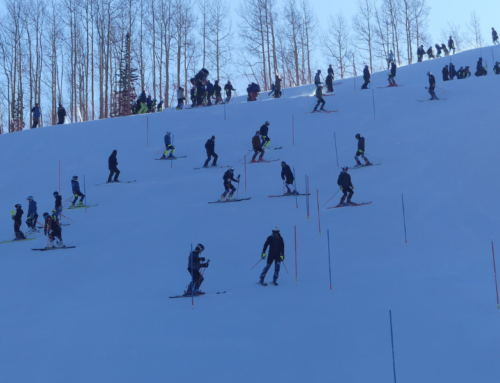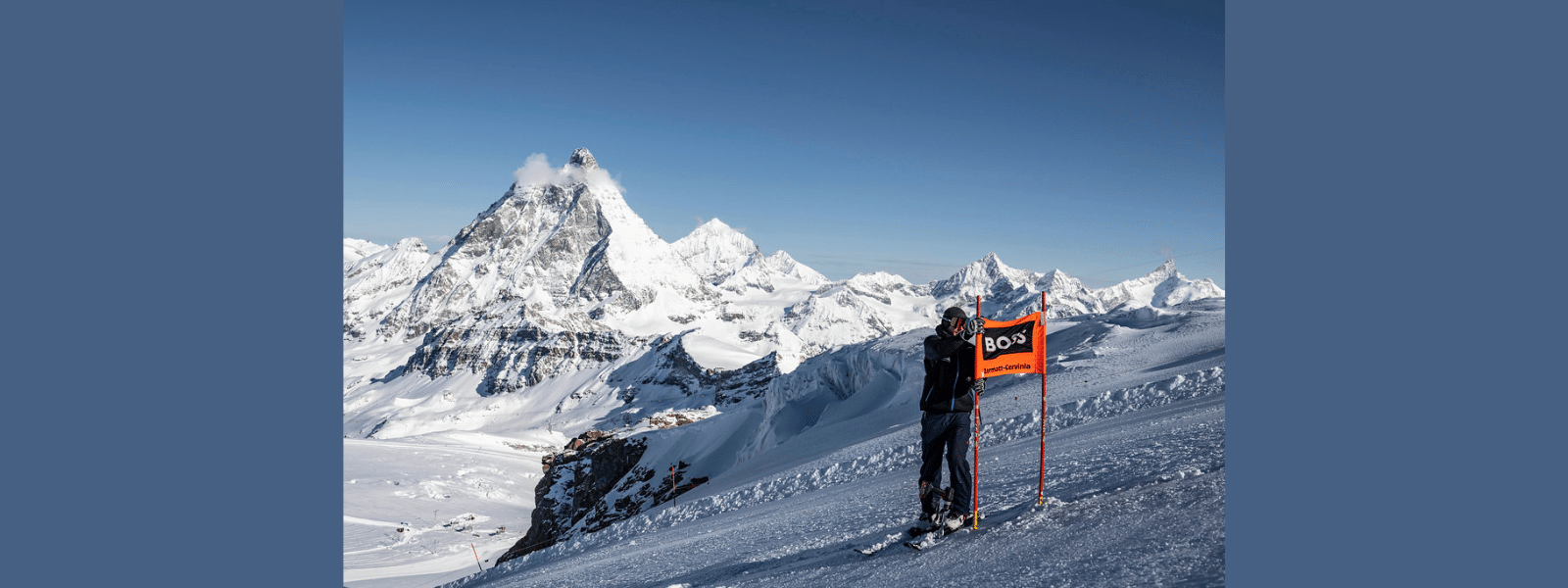Bode Miller makes history in Lake Louise
Bode Miller makes history in Lake Louise Karl Schranz called it.
Karl Schranz called it.
Last month at the World Cup opener in Soelden, Austria, the legendary Olympic downhiller said that Bode Miller had a chance to win World Cup speed races.
“He needs to start fewer downhills,” said Schranz. “But at Lake Louise he has the chance.”
Miller saw his chance, and took it this weekend, winning the downhill and super G at Lake Louise and making history as the first American man to win World Cup races in all five disciplines. After three consecutive World Cup wins, Miller is positioning himself for the World Cup overall championship season that has eluded his grasp in recent years.
Miller gets noticeably upset when reporters suggest that he came to speed events late in his career.
“I’m not a rookie,” said Miller in a post-race teleconference with reporters from around the country. “I’ve been doing this for a long time. There are a lot of pieces that have to fall into place, and they’re falling into place now.”
Miller won the season-opening giant slalom a month ago in Austria. That’s the event where he won the discipline title last season. But Miller’s speed event performances were spotty recently; he blamed his equipment, while others suggested he was stretching himself too thin by racing in every World Cup race on the schedule.
Then this summer Miller switched to Atomic, the leading manufacturer in speed events, and picked up one of the World Cup’s top-rated servicemen. Now his speed results are coming fast and furious — two wins in two days, on a race hill where it was least expected.
“I can be more aerodynamic now,” Miller told reporters in Austria. “I was doing so much to compensate for my awkward set-up that my chest was always up. I’d end up needing to make up all my time on the turny parts of the courses.”
Now Miller has won two speed events at Lake Louise. His teammate and friend Daron Rahlves came in fifth in both of those runs. And the two of them are flying on Monday to Beaver Creek, where the courses are much more technically demanding than Lake Louise, which suits the skiing style of the American duo.
“If you look at it from a distance, it’s a huge breakthrough,” says Miller. “But I’ve won splits in almost every speed race I’ve been in in recent years. That’s been happening since I was on K2. I was getting top-10’s even six years ago.”
Last year at St. Anton, Schranz began advising Miller to scale back his speed-event skiing and focus on his supposed strengths (slalom and GS). Shranz and Miller chat like old friends, and hung out together at St. Anton last year, after Miller won the slalom there. “I told him ‘You can win the overall World Cup, but you need to think.'”
But Miller insisted that once he got his equipment dialed, he’d be fast in downhill and super G. And all along, he reminded reporters that he was no speed-event rookie. He would support his argument in a way that ski writers find both humbling and hilarious: By calling up a bottomless store of stats that justify his statements, such as the fact that he was eighth at JO’s back in 1995, or that he won splits in the downhill training runs at the St. Anton world championships in 2001, right before he blew his knee out.
As a junior racer, Miller raced at Maine’s Carrabassett Valley Academy, under the tutelage of Chip Cochrane, a former national team downhiller. “Sugarloaf’s certainly a good mountain to learn to ski on,” said Cochrane last year in a Ski Racing interview. “You can go fast here. Fast free-skiing is something you hear a lot of coaches saying their athletes don’t get to do. Mid-week there’s no one here. When CVA shows up at 9:45, we’re 90 percent of the people on the hill.”
Cochrane took his charges out on the hill and told them to let it rip. Forrest Carey, who raced with Miller at CVA and then on the national team, told Ski Racing last year that Cochrane’s coaching style might have encouraged the go-for-broke brand of skiing that Miller uses on the World Cup now. ‘It’s not ‘get your hands up,’ says Carey. “‘It’s ‘go straighter.’ It’s the mind-set of having big [ones], going direct, letting us go out and ski fast. Just ski fast. It’s not safe, and it’s not what the areas want, but there’s nothing better for an athlete.’
World Cup
Men’s Super G
Lake Louise, Alberta
Nov. 28, 2004
1. Bode Miller, USA 1:28.18
2. Hermann Maier, AUT 1:28.32
3. Michael Walchhofer, AUT 1:28.73
4. Johann Grugger, AUT 1:28.84
5. Daron Rahlves, USA 1:28.86
6. Benjamin Raich, AUT 1:28.94
7. Mario Scheiber, AUT 1:29.06
8. Hans Knauss, AUT 1:29.25
9. Didier Defago, SUI 1:29.38
10. Florian Eckert, GER 1:29.40
11. Ambrosi Hoffmann, SUI 1:29.45
12. Marco Buechel, LIE 1:29.52
13. Mathias Lanzinger, SUI 1:29.60
14. Kjetil Andre Aamodt, NOR 1:29.70
15. Patrik Jaerbyn, SWE 1:29.73
16. Lasse Kjus, NOR 1:29.74
17. Juerg Gruenenfelder, SUI 1:29.76
17. Andreas Schifferer, AUT 1:29.76
17. Aksel Lund Svindal, NOR 1:29.76
17. Stephan Goergl, AUT 1:29.76
21. Erik Guay, CAN 1:29.81
22. Peter Fill, ITA 1:29.86
23. Christoph Gruber, AUT 1:29.91
24. Antoine Deneriaz, FRA 1:29.97
25. Bruno Kernen, SUI 1:30.03
26. Tobias Gruenenfelder, SUI 1:30.08
27. Andreas Ertl, GER 1:30.10
28. Bryon Friedman, USA 1:30.11
28. Pierre-Emmanuel Dalcin, FRA 1:30.11
30. Bjarne Solbakken, NOR 1:30.16
30. Alessandro Fattori, ITA 1:30.16
other North Americans:
32. Jan Hudec, CAN 1:30.21
39. Francois Bourque, CAN 1:30.64
42. Scott Macartney, USA 1:30.78
43. Jeff Hume, CAN 1:30.92
45. Erik Schlopy, USA 1:31.04
48. Jakub Fiala, USA 1:31.07
55. Dane Spencer, USA 1:31.63
57. Wade Bishop, USA 1:31.85
DNF: Vincent Lavoie, John Kucera, CAN.
THE SCOOP
By Hank McKee
Equipment
Lake Louise Men’s super G, Nov. 28, 2004
1 Miller, Atomic/Atomic/Atomic
2 Maier, Atomic/Lange/Atomic
3 Walchhofer, Atomic/Lange/Atomic
4 Grugger, Head/Lange/Tyrolia
5 Rahlves, Atomic/Atomic/Atomic
6 Raich, Atomic/Atomic/Atomic
7 Scheiber, Atomic/Lange/Atomic
8 Knauss, Fischer/Lange/Fischer
9 Defago, Rossignol/Rossignol/Rossignol
10 Eckert, Atomic/Lange/Atomic
Lake Louise Men’s Super G, 11/28/2004. … It is the third race of a 34 race men’s World Cup schedule (plus three combineds). … It is the first of seven scheduled men’s super G’s. It is the 250th World Cup super G held.
It is the 15th career World Cup win for Bode Miller, … his first in super G. … It is his third win of the season, each in different disciplines. … It is the 145th U.S. World Cup win. … Miller is third on the all-time list of U.S. winners, behind Phil Mahre’s 27 wins and Tamara McKinney’s 18. … McKinney was the last American to win three straight World Cup races – at Waterville Valley and Vail in March 1983. … Miller wins by .14 of a second. … Americans have won two of the last three, and three of the last five men’s SG’s. … Miller joins Picabo Street as the only Americans to win twice at Lake Louise. … Miller also won the Solden GS 10/24 and the Lake Louise DH 11/27 previously this season.
It is the 80th career podium result for Hermann Maier. … his 30th in SG. … It is his first podium of the season. … He won the last men’s SG at Lake Louise 11/30/2003. … It is the 17th career podium for Michael Walchhofer, … his third in SG and his second in SG at Lake Louise (2nd 11/30/2003). … It is his second third place finish in two days. …
It is the 26th career top five for Daron Rahlves. … His eighth in SG … He missed fourth place by .02 of a second. … Rahlves has been fifth twice in two days. … Austria and the U.S. collected all of the top eight place
s.
It is the 12th World Cup scoring finish for Erik Guay, his second of the season. … It is the 11th scoring finish for Bryon Friedman, his first of the season. … Jan Hudec missed scoring a point by .05 of a second.
Miller’s lead in the overall standings increases to 164pts as he leads Hermann Maier 300-136 with Walchhofer third at 135. … Rahlves is fifth with 90pts.The Austrian men lead the U.S. men 729-413 in the Nations Cup.





















